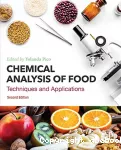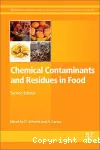Adresse
Infodoc : Réseau des bibliothèques et centres de documentation d'AgroParisTechFrance
contact

Catégories
|
RAMEAU , Nom commun , Chromatographie
ChromatographieSynonyme(s)Analyse chromatographique Rétention chromatographique |
Documents disponibles dans cette catégorie (24)
 Ajouter le résultat dans votre panier Faire une suggestion Affiner la recherche Interroger des sources externes
Ajouter le résultat dans votre panier Faire une suggestion Affiner la recherche Interroger des sources externes
 Thèse
Thèse
 Livre
Livre978-1-4822-4543-11 vol. (XXII-639 p.)
1 vol. (XXII-639 p.)ISBN : 978-1-4822-4543-1 
 Livre
Livre978-0-12-813266-11 vol. (XVI-889 p.)
1 vol. (XVI-889 p.)ISBN : 978-0-12-813266-1 
 Livre
Livre978-0-08-100674-01 vol. (XII-605 p.)
1 vol. (XII-605 p.)ISBN : 978-0-08-100674-0 
 Livre
Livre978-2-7430-2039-21 vol. (XXII-553 p.-[8] p. de pl.)
1 vol. (XXII-553 p.-[8] p. de pl.)ISBN : 978-2-7430-2039-2 
 Livre
Livre978-0-250-40307-31 vol. (XVIII, 551 p.)
1 vol. (XVIII, 551 p.)ISBN : 978-0-250-40307-3 
 Thèse1 vol. (123 p.)
Thèse1 vol. (123 p.)
1 vol. (123 p.)
 Thèse1 vol. (283 p.)
Thèse1 vol. (283 p.)
1 vol. (283 p.)
 Livre
Livre
 Thèse
Thèse
 Livre
Livre978-3-319-45774-11 vol. (XX-649 p.)
1 vol. (XX-649 p.)ISBN : 978-3-319-45774-1 
 Livre
Livre978-1-138-33824-11 vol. (XVIII-726 p.)
1 vol. (XVIII-726 p.)ISBN : 978-1-138-33824-1 
 Livre
Livre978-2-10-082188-41 vol. (XVII-574 p.)
1 vol. (XVII-574 p.)ISBN : 978-2-10-082188-4 
 Livre
Livre978-0-12-812002-61 vol. (XV-323 p.)
1 vol. (XV-323 p.)ISBN : 978-0-12-812002-6 
 Livre
Livre978-0-08-100352-71 vol. (XXXI-337 p.)
1 vol. (XXXI-337 p.)ISBN : 978-0-08-100352-7 
 Thèse1 vol. (253 p.)
Thèse1 vol. (253 p.)
1 vol. (253 p.)
 LivreBr. 210.00 FRF
LivreBr. 210.00 FRF978-2-84433-041-31 vol. (235 p.)
1 vol. (235 p.)Prix : Br. 210.00 FRF ISBN : 978-2-84433-041-3 
 Livre
Livre978-1-138-37069-21 vol. (XIV-198 p.)
1 vol. (XIV-198 p.)ISBN : 978-1-138-37069-2 
 Livre
Livre978-0-7923-3946-51 vol. (XXI-523 p.)
1 vol. (XXI-523 p.)ISBN : 978-0-7923-3946-5 
 Livre90 EUR
Livre90 EUR978-2-7430-0878-91 vol. (XIV-320 p.)
1 vol. (XIV-320 p.)Prix : 90 EUR ISBN : 978-2-7430-0878-9 
 Livre
Livre978-0-12-814264-61 vol. (XXVII-777 p.)
1 vol. (XXVII-777 p.)ISBN : 978-0-12-814264-6 
 Thèse
Thèse
 Thèse1 vol. (198 p. - pagination multiple)
Thèse1 vol. (198 p. - pagination multiple)
1 vol. (198 p. - pagination multiple)
 Livre
Livre978-3-319-27026-51 vol. (XVII-657 p.)
1 vol. (XVII-657 p.)ISBN : 978-3-319-27026-5





